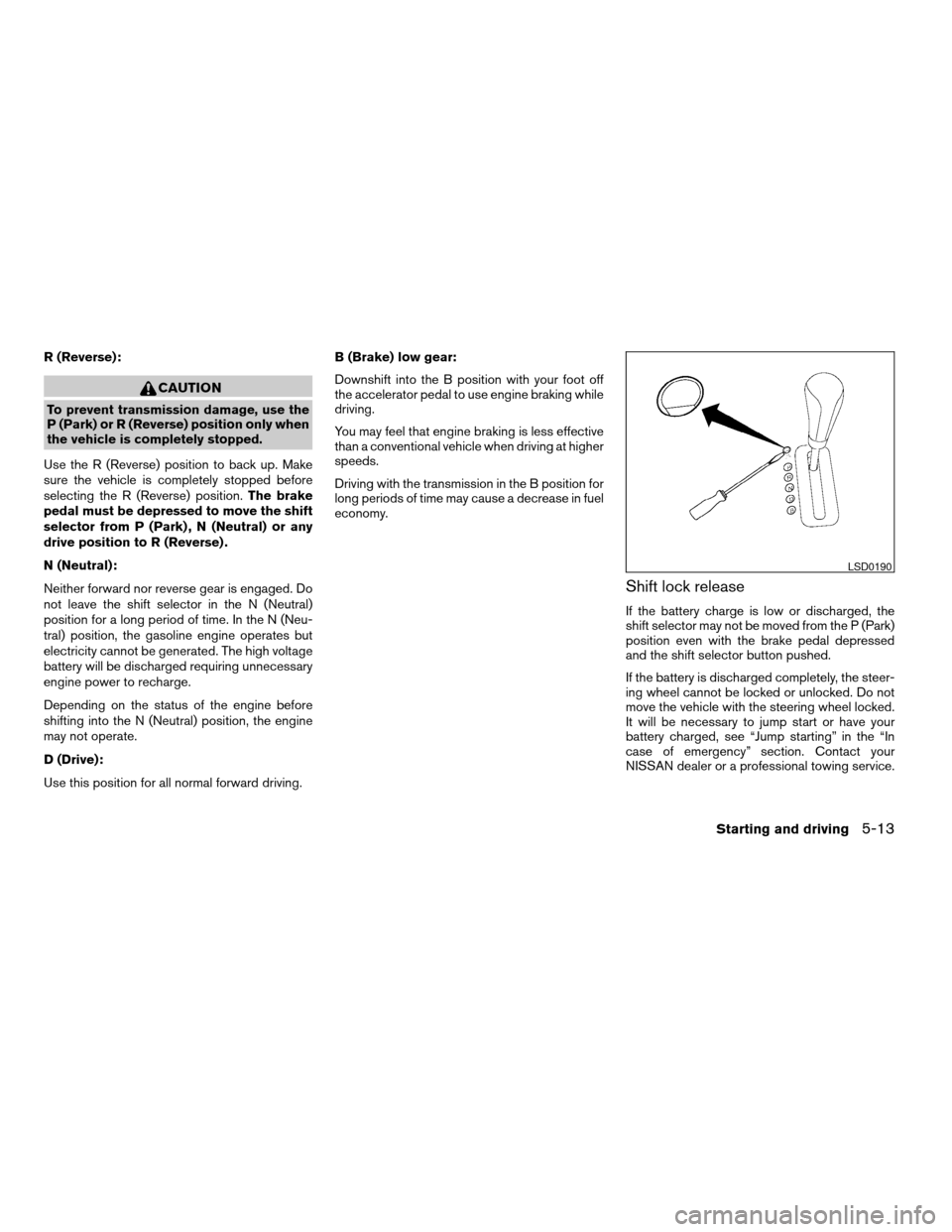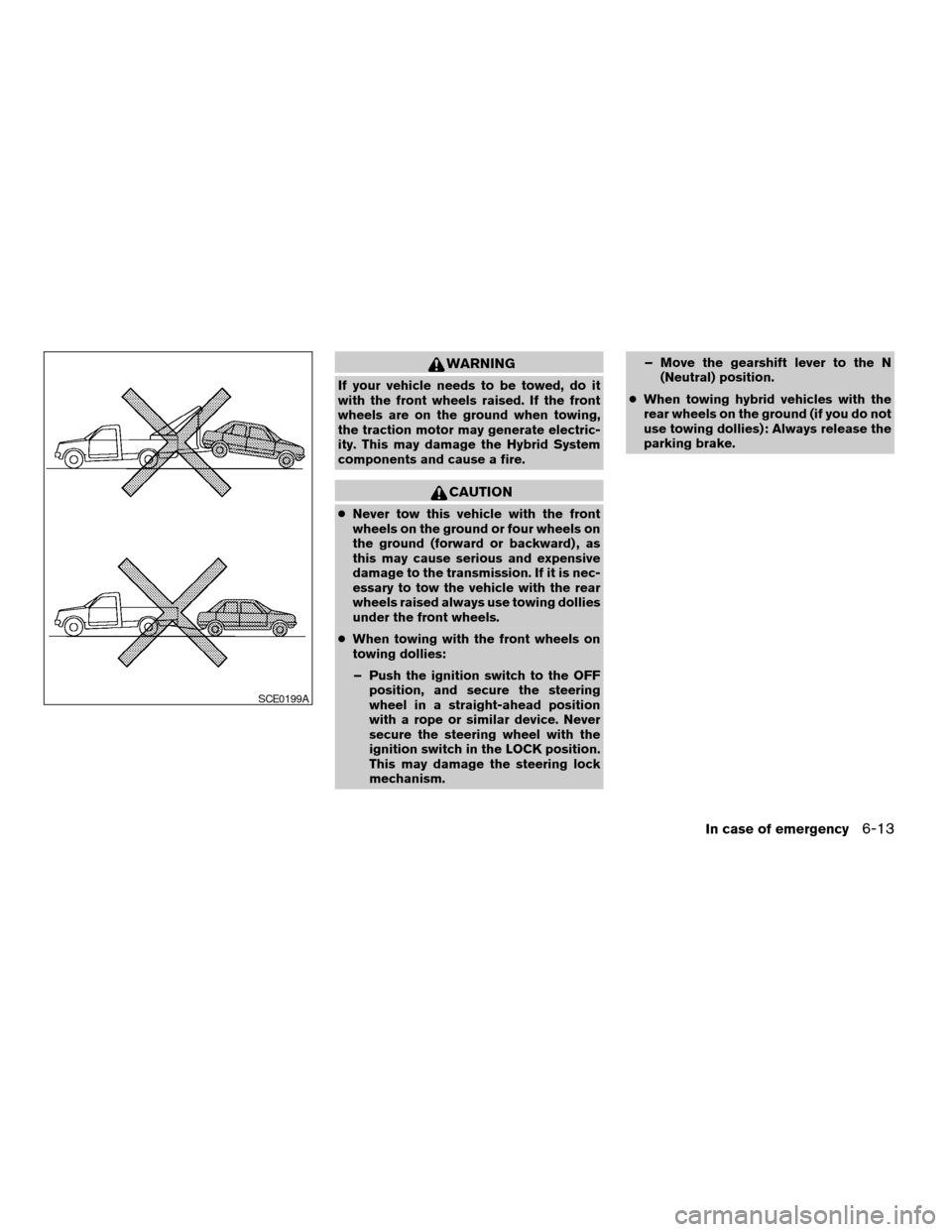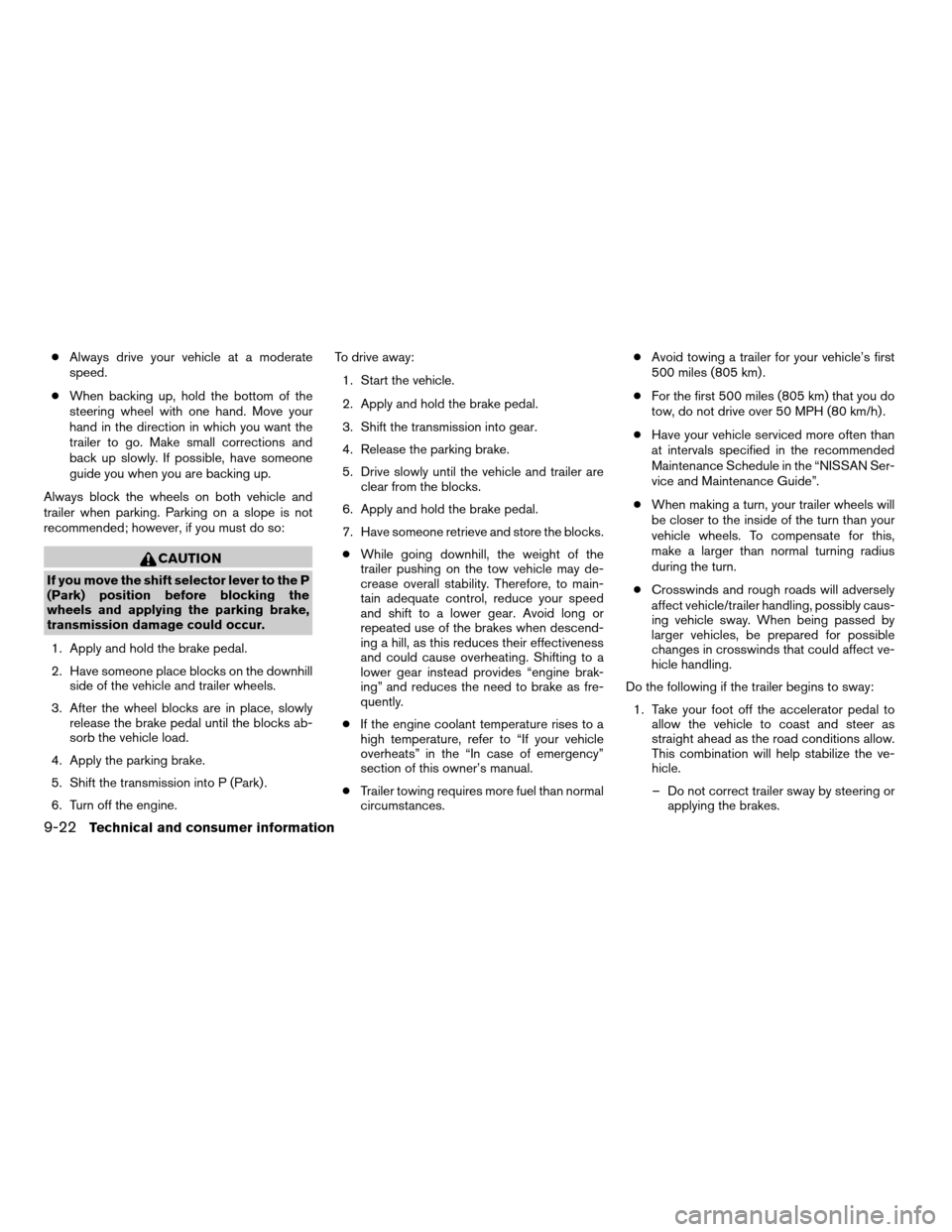2009 NISSAN ALTIMA HYBRID emergency towing
[x] Cancel search: emergency towingPage 8 of 353

WARNING
cPull your vehicle off the road, put the
transmission in the P (Park) position,
apply the parking brake and turn the
Hybrid System off.
cCheck to see if there are exposed high
voltage parts and cables. Never touch
the parts and cables. See “High voltage
components”, later in this section for
the locations of the high voltage parts
and cables.
cTo avoid personal injury, do not touch
high voltage wiring, connectors and
high voltage parts (inverter unit, high
voltage battery etc.) .
cIf exposed electric wires are visible in-
side or outside of your vehicle, an elec-
tric shock may occur. Never touch the
electric wires.
cInspect the ground under the vehicle. If
liquid has leaked onto the ground, the
fuel system may have been damaged.
Leave the vehicle as soon as possible.cNever touch fluid leaks inside or out-
side the vehicle. The leak may be strong
alkaline electrolyte from the high volt-
age battery. If it contacts your skin or
eyes, wash it off immediately with a
large amount of water or if possible,
boric acid solution. Get immediate
medical attention to help avoid serious
injury.
cIf a fire occurs in the hybrid vehicle,
leave the vehicle as soon as possible.
Never use a fire extinguisher that is not
meant for use on electric fires. Using
even a small amount of water may be
also dangerous.
cIf your vehicle needs to be towed, do it
with the front wheels raised. If the front
wheels are on the ground when towing,
the traction motor may generate elec-
tricity. This may damage the Hybrid Sys-
tem components and cause a fire.
EMERGENCY SHUT OFF SYSTEM
The emergency shut off system automatically
turns off the high voltage current in certain frontal
collisions. This is to minimize the risk of electrical
short circuits. If the system activates, your vehicle
will not restart. To restart the Hybrid System,
contact a NISSAN dealer.The Hybrid System monitors the status of power
being sent to the traction motor and the battery
state of charge. The status is shown on the hybrid
power meter and high voltage battery status
meter. System status can also be shown on the
navigation system display (if so equipped) when
the screen is in the Energy Flow mode or energy/
fuel history mode.
ROAD ACCIDENT CAUTIONS ENERGY MONITORS
HEV OverviewHEV-3
ZREVIEW COPYÐ2009 Altima Hybrid Electric
(ahv)
Owners ManualÐCanadian_French(fr_can)
06/14/08Ðdebbie
X
Page 240 of 353

R (Reverse):
CAUTION
To prevent transmission damage, use the
P (Park) or R (Reverse) position only when
the vehicle is completely stopped.
Use the R (Reverse) position to back up. Make
sure the vehicle is completely stopped before
selecting the R (Reverse) position.The brake
pedal must be depressed to move the shift
selector from P (Park) , N (Neutral) or any
drive position to R (Reverse) .
N (Neutral):
Neither forward nor reverse gear is engaged. Do
not leave the shift selector in the N (Neutral)
position for a long period of time. In the N (Neu-
tral) position, the gasoline engine operates but
electricity cannot be generated. The high voltage
battery will be discharged requiring unnecessary
engine power to recharge.
Depending on the status of the engine before
shifting into the N (Neutral) position, the engine
may not operate.
D (Drive):
Use this position for all normal forward driving.B (Brake) low gear:
Downshift into the B position with your foot off
the accelerator pedal to use engine braking while
driving.
You may feel that engine braking is less effective
than a conventional vehicle when driving at higher
speeds.
Driving with the transmission in the B position for
long periods of time may cause a decrease in fuel
economy.
Shift lock release
If the battery charge is low or discharged, the
shift selector may not be moved from the P (Park)
position even with the brake pedal depressed
and the shift selector button pushed.
If the battery is discharged completely, the steer-
ing wheel cannot be locked or unlocked. Do not
move the vehicle with the steering wheel locked.
It will be necessary to jump start or have your
battery charged, see “Jump starting” in the “In
case of emergency” section. Contact your
NISSAN dealer or a professional towing service.
LSD0190
Starting and driving5-13
ZREVIEW COPYÐ2009 Altima Hybrid Electric
(ahv)
Owners ManualÐCanadian_French(fr_can)
06/16/08Ðdebbie
X
Page 254 of 353

6 In case of emergency
Flat tire...........................................6-2
Tire Pressure Monitoring System (TPMS)..........6-2
Changing a flat tire.............................6-2
Hybrid system stops operating while driving..........6-7
Vehicle does not start..............................6-8
Confirm battery is discharged....................6-8
Emergency Start...............................6-8Jump starting.....................................6-8
Push starting.....................................6-11
If your vehicle overheats...........................6-11
Towing your vehicle...............................6-12
Towing recommended by NISSAN..............6-12
Vehicle recovery (freeing a stuck vehicle).........6-14
ZREVIEW COPYÐ2009 Altima Hybrid Electric
(ahv)
Owners ManualÐCanadian_French(fr_can)
06/16/08Ðdebbie
X
Page 265 of 353

When towing your vehicle, all State (Provincial in
Canada) and local regulations for towing must be
followed. Incorrect towing equipment could dam-
age your vehicle. Towing instructions are avail-
able from a NISSAN dealer. Local service opera-
tors are generally familiar with the applicable laws
and procedures for towing. To assure proper
towing and to prevent accidental damage to your
vehicle, NISSAN recommends having a service
operator tow your vehicle. It is advisable to have
the service operator carefully read the following
precautions:
WARNING
cNever ride in a vehicle that is being
towed.
cNever get under your vehicle after it has
been lifted by a tow truck.
CAUTION
cWhen towing, make sure that the trans-
mission, axles, steering system and
powertrain are in working condition. If
any of these conditions apply, dollies or
a flatbed tow truck must be used.
cAlways attach safety chains before
towing.For information about towing your vehicle behind
a recreational vehicle (RV) , refer to “Flat towing”
in the “Technical and consumer information” sec-
tion of this manual.
TOWING RECOMMENDED BY
NISSAN
NISSAN recommends that your vehicle be towed
with the driving (front) wheels off the ground or
place the vehicle on a flat bed truck as illustrated.
ACE0511
TOWING YOUR VEHICLE
6-12In case of emergency
ZREVIEW COPYÐ2009 Altima Hybrid Electric
(ahv)
Owners ManualÐCanadian_French(fr_can)
06/16/08Ðdebbie
X
Page 266 of 353

WARNING
If your vehicle needs to be towed, do it
with the front wheels raised. If the front
wheels are on the ground when towing,
the traction motor may generate electric-
ity. This may damage the Hybrid System
components and cause a fire.
CAUTION
cNever tow this vehicle with the front
wheels on the ground or four wheels on
the ground (forward or backward) , as
this may cause serious and expensive
damage to the transmission. If it is nec-
essary to tow the vehicle with the rear
wheels raised always use towing dollies
under the front wheels.
cWhen towing with the front wheels on
towing dollies:
– Push the ignition switch to the OFF
position, and secure the steering
wheel in a straight-ahead position
with a rope or similar device. Never
secure the steering wheel with the
ignition switch in the LOCK position.
This may damage the steering lock
mechanism.– Move the gearshift lever to the N
(Neutral) position.
cWhen towing hybrid vehicles with the
rear wheels on the ground (if you do not
use towing dollies): Always release the
parking brake.
SCE0199A
In case of emergency6-13
ZREVIEW COPYÐ2009 Altima Hybrid Electric
(ahv)
Owners ManualÐCanadian_French(fr_can)
06/16/08Ðdebbie
X
Page 267 of 353

VEHICLE RECOVERY (freeing a stuck
vehicle)
Pulling a stuck vehicle
Do not use the hook to tow the vehicle.
WARNING
cStand clear of a stuck vehicle.
cDo not spin your tires at high speed.
This could cause them to explode and
result in serious injury. Parts of your
vehicle could also overheat and be
damaged.
CAUTION
cTow chains or cables must be attached
only to the main structural members of
the vehicle or the towing hooks (if so
equipped) . Otherwise, the vehicle body
will be damaged.
cDo not use the vehicle tie downs to free
a vehicle stuck in sand, snow, mud, etc.
Never tow the vehicle using the vehicle
tie downs or recovery hooks.
cAlways pull the cable straight out from
the front or rear of the vehicle. Never
pull the vehicle at an angle.
cPulling devices should be routed so
they do not touch any part of the high
voltage harness, suspension, steering,
brake or cooling systems.
cPulling devices such as ropes or canvas
straps are not recommended for use in
vehicle towing or recovery.
Rocking a stuck vehicle
If your vehicle is stuck in sand, snow, mud, etc.,
use the following procedure:
1. Make sure the area in front and behind the
vehicle is clear of obstructions.2. Turn the steering wheel right and left to clear
an area around the front tires.
3. Slowly rock the vehicle forward and back-
ward.
cShift back and forth between R (Reverse)
and D (Drive) .
cApply the accelerator as little as possible
to maintain the rocking motion.
cRelease the accelerator pedal before
shifting between R (Reverse) and D
(Drive) .
cDo not spin the tires above 35 mph (55
km/h) .
4. If the vehicle cannot be freed after a few
tries, contact a professional towing service
to remove the vehicle.
LCE0145
6-14In case of emergency
ZREVIEW COPYÐ2009 Altima Hybrid Electric
(ahv)
Owners ManualÐCanadian_French(fr_can)
06/16/08Ðdebbie
X
Page 339 of 353

cAlways drive your vehicle at a moderate
speed.
cWhen backing up, hold the bottom of the
steering wheel with one hand. Move your
hand in the direction in which you want the
trailer to go. Make small corrections and
back up slowly. If possible, have someone
guide you when you are backing up.
Always block the wheels on both vehicle and
trailer when parking. Parking on a slope is not
recommended; however, if you must do so:
CAUTION
If you move the shift selector lever to the P
(Park) position before blocking the
wheels and applying the parking brake,
transmission damage could occur.
1. Apply and hold the brake pedal.
2. Have someone place blocks on the downhill
side of the vehicle and trailer wheels.
3. After the wheel blocks are in place, slowly
release the brake pedal until the blocks ab-
sorb the vehicle load.
4. Apply the parking brake.
5. Shift the transmission into P (Park) .
6. Turn off the engine.To drive away:
1. Start the vehicle.
2. Apply and hold the brake pedal.
3. Shift the transmission into gear.
4. Release the parking brake.
5. Drive slowly until the vehicle and trailer are
clear from the blocks.
6. Apply and hold the brake pedal.
7. Have someone retrieve and store the blocks.
cWhile going downhill, the weight of the
trailer pushing on the tow vehicle may de-
crease overall stability. Therefore, to main-
tain adequate control, reduce your speed
and shift to a lower gear. Avoid long or
repeated use of the brakes when descend-
ing a hill, as this reduces their effectiveness
and could cause overheating. Shifting to a
lower gear instead provides “engine brak-
ing” and reduces the need to brake as fre-
quently.
cIf the engine coolant temperature rises to a
high temperature, refer to “If your vehicle
overheats” in the “In case of emergency”
section of this owner’s manual.
cTrailer towing requires more fuel than normal
circumstances.cAvoid towing a trailer for your vehicle’s first
500 miles (805 km) .
cFor the first 500 miles (805 km) that you do
tow, do not drive over 50 MPH (80 km/h) .
cHave your vehicle serviced more often than
at intervals specified in the recommended
Maintenance Schedule in the “NISSAN Ser-
vice and Maintenance Guide”.
cWhen making a turn, your trailer wheels will
be closer to the inside of the turn than your
vehicle wheels. To compensate for this,
make a larger than normal turning radius
during the turn.
cCrosswinds and rough roads will adversely
affect vehicle/trailer handling, possibly caus-
ing vehicle sway. When being passed by
larger vehicles, be prepared for possible
changes in crosswinds that could affect ve-
hicle handling.
Do the following if the trailer begins to sway:
1. Take your foot off the accelerator pedal to
allow the vehicle to coast and steer as
straight ahead as the road conditions allow.
This combination will help stabilize the ve-
hicle.
– Do not correct trailer sway by steering or
applying the brakes.
9-22Technical and consumer information
ZREVIEW COPYÐ2009 Altima Hybrid Electric
(ahv)
Owners ManualÐCanadian_French(fr_can)
06/16/08Ðdebbie
X
Page 340 of 353

2. When the trailer sway stops, gently apply the
brakes and pull to the side of the road in a
safe area.
3. Try to rearrange the trailer load so it is bal-
anced as described earlier in this section.
cBe careful when passing other vehicles.
Passing while towing a trailer requires con-
siderably more distance than normal pass-
ing. Remember, the length of the trailer must
also pass the other vehicle before you can
safely change lanes.
cDownshift the transmission to a lower gear
for engine braking when driving down steep
or long hills. This will help slow the vehicle
without applying the brakes.
cAvoid holding the brake pedal down too long
or too frequently. This could cause the
brakes to overheat, resulting in reduced
braking efficiency.
cIncrease your following distance to allow for
greater stopping distances while towing a
trailer. Anticipate stops and brake gradually.
cNISSAN recommends that the cruise con-
trol not be used while towing a trailer.cSome states or provinces have specific
regulations and speed limits for vehicles that
are towing trailers. Obey the local speed
limits.
cCheck your hitch, trailer wiring harness con-
nections, and trailer wheel lug nuts after 50
miles (80 km) of travel and at every break.
cWhen launching a boat, don’t allow the wa-
ter level to go over the exhaust tail pipe or
rear bumper.
cMake sure you disconnect the trailer lights
before backing the trailer into the water or
the trailer lights may burn out.
When towing a trailer, eCVT fluid should be
changed more frequently. For additional
information, see the “Maintenance and do-
it-yourself” section earlier in this manual.
FLAT TOWING
Towing your vehicle with all four wheels on the
ground is sometimes called flat towing. This
method is sometimes used when towing a vehicle
behind a recreational vehicle, such as a motor
home.
Your vehicle is not designed to be flat towed with
all four wheels on the ground.
CAUTION
cFailure to follow these guidelines can
result in severe transmission damage.
cDO not tow your vehicle with four
wheels on the ground. This may cause
serious damage to your vehicle.
cDO NOT tow this vehicle with all four
wheels on the ground (flat towing) . Do-
ing so WILL DAMAGE internal transmis-
sion parts due to lack of transmission
lubrication.
cFor emergency towing procedures refer
to “Towing recommended by NISSAN”
in the “In case of emergency” section of
this manual.
Electronically controlled Continuously
Variable Transmission (eCVT)
To tow a vehicle equipped with an eCVT, an
appropriate vehicle dollyMUSTbe placed under
the towed vehicle’s drive wheels.Alwaysfollow
the dolly manufacturer’s recommendations when
using their product.
Technical and consumer information9-23
ZREVIEW COPYÐ2009 Altima Hybrid Electric
(ahv)
Owners ManualÐCanadian_French(fr_can)
06/16/08Ðdebbie
X